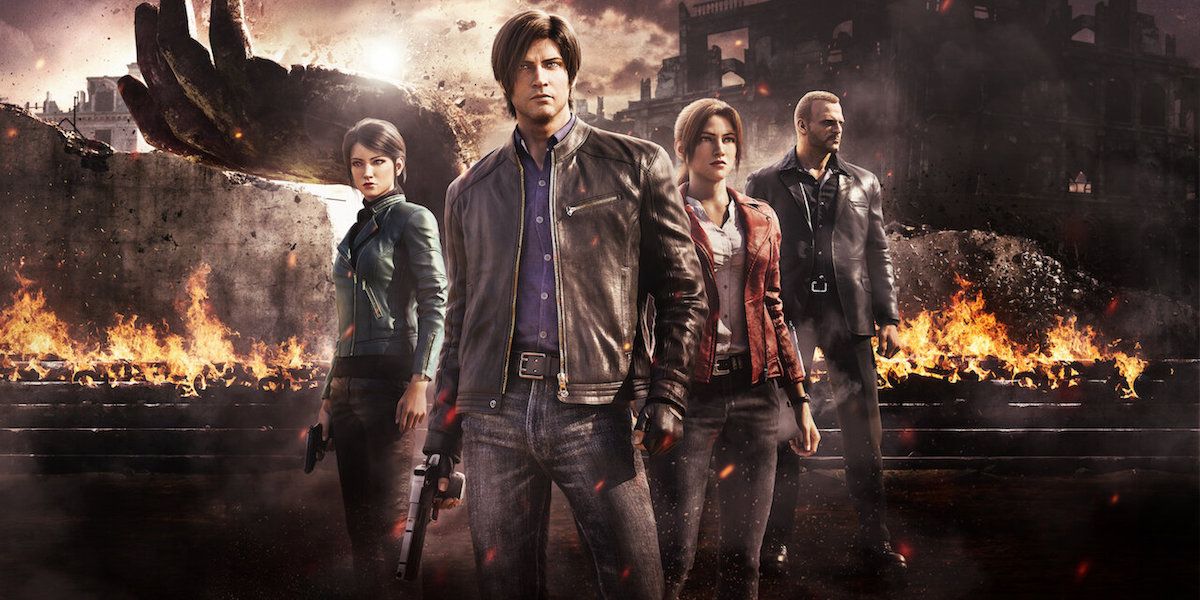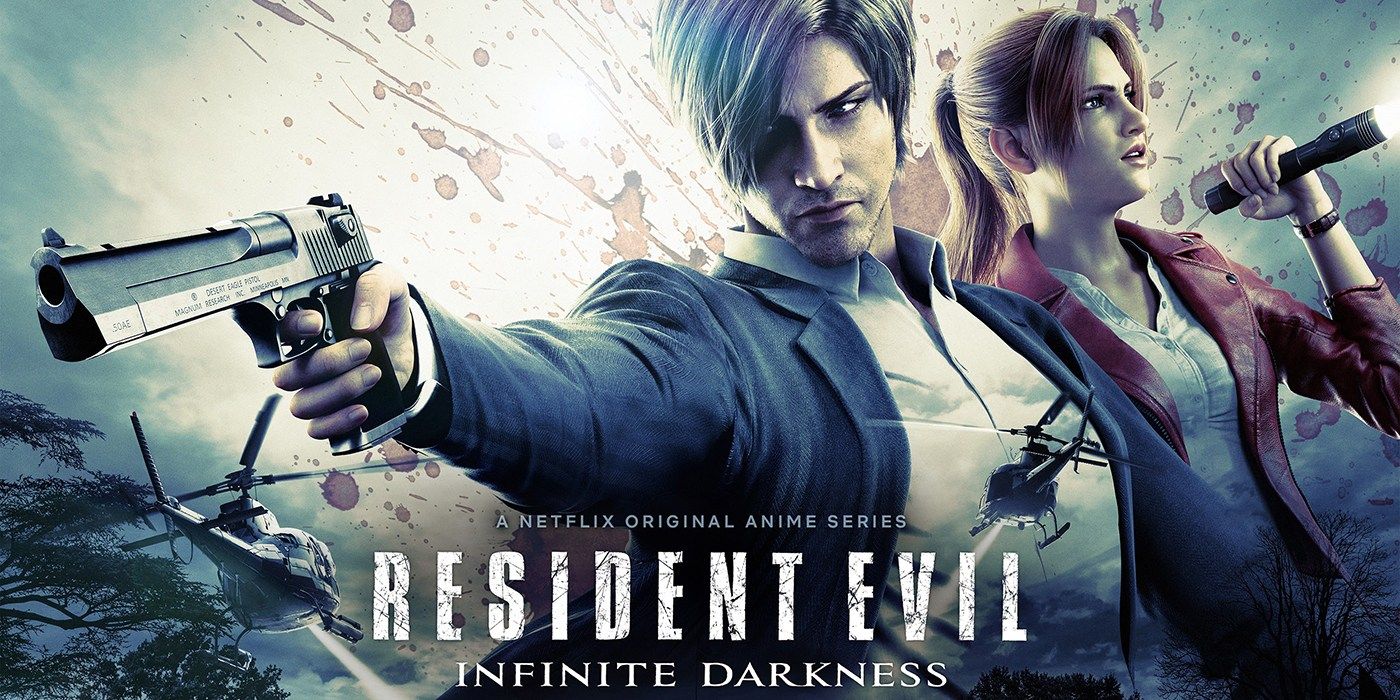
Over the past 25 years, Resident Evil has built itself up as one of the biggest video game franchises of all time. Across dozens of main titles, remakes, and spin-offs, the Resident Evil universe, with all of its heroes, villains, monsters, and corporate espionage, has become the longest running "soap opera" in the medium; while the series has reinvented itself numerous times, it still holds true to the original continuity that began back in 1996.
Starting with 2008's Resident Evil: Degeneration, the franchise expanded to include animated movies. Unlike the live-action movies spearheaded by Paul W.S. Anderson, Degeneration, as well as sequels Damnation and Vendetta, are all set within the same continuity as the games, featuring the original canon versions of characters like Claire, Chris, and Leon. The latest chapter in the ongoing Resident Evil saga, Resident Evil: Infinite Darkness, is a four-part Netflix CG anime miniseries. Set in 2006, two years after the events of Resident Evil 4, Infinite Darkness follows Claire and Leon as they embark on a journey of international intrigue and dangerous bio organic weapons.
While promoting the release of Resident Evil: Infinite Darkness, director Eiichirō Hasumi spoke to Screen Rant about his work on the series, including taking on Capcom's horror/action juggernaut as his first-ever animated project. He discusses working with Capcom to stay true to the characters and tell a story that reflects who they are at this point in the massive Resident Evil timeline. He also discusses his approach to shooting mo-cap actors and allowing the story to breathe with quiet, dramatic moments in between all of the action and excitement that franchise fans have come to expect.
Resident Evil: Infinite Darkness is out now on Netflix.

Director Hasumi, it's a pleasure to talk to you, especially since I enjoyed Infinite Darkness very much.
Thank you so much for those kind words.
Resident Evil, across the games and the CG anime over the years, has always taken different approaches, especially towards the action. Sometimes there's slow zombies, and sometimes there's gigantic monsters, the style is always very different. Did you have the creative freedom to make "your version" of Resident Evil?
With regard to the zombies and the creatures, I did get a lot of input from the staff who worked on the full CG animation, because they had already been part of the Resident Evil franchise in the past. But for the actual approach, it was very live-action-style, which is my background. This is my first full CG animation attempt. I felt like that really worked, that live action approach, and I was given a lot of freedom.
Building off of that, since this is your first animation, was there a learning curve for you? Were you surprised by how different or how similar it was to shoot, both the action and the quiet drama scenes, in CG?
We used mo-cap, so that involved working with the actors, they were live people to direct. It was really not that different from live-action directing in terms of working with the performers. The producers told me, at the beginning, that you had to keep in mind that this is animation, so performances may not be able to maintain attention or atmosphere as much as you would be able to do in live action. But actually having done this in animation, I felt that, because the performances are based on actual people performing these characters, I didn't really feel that it was difficult to maintain that tension or mood or what have you. The things I found difficult due to the animation that surprised me because I didn't know beforehand was that using water is costly, and that any scene where the characters are eating is equally costly.

Saying that made me think of one my favorite scenes, it's in episode two, with Leon and Jason in the submarine. They discuss their shared trauma. At this point, the visuals are so high-end that it's... If not fully indistinguishable from live-action, at least the performances feel completely natural. I think that scene is a little masterpiece of filmmaking, CGI or live-action completely aside.
That scene, with Leon and Jason, as you mentioned, they talk about their shared experience in different settings. They both are men who have seen hell. That was a moment when they're able to sympathize with each other. Even when writing the script, it was a really important scene for me to nail. And that was actually one of the scenes the producers were really worried about! They were telling me, "Make sure you remember this is animation," about maintaining that tension and so forth. And because of that, I did feel a little bit apprehensive. That's why I added, before the conversation, that rat scene. It's foreboding, but it also maintains the viewer's attention, makes sure they have a dangling carrot, in case the conversation wasn't able to maintain the tension. It really was a challenge, because in the early stages of editing, there's no face! There's no facial expressions on the characters. So I was worried at that point. But then as the quality got better and better and you finally had the expressions as well, I feel like it really worked.
In this series, you get to play with new characters and established favorites. Claire and Leon have been fan-favorites for more than 20 years. Is Capcom fiercely protective of them? What's the level of freedom you have to push the characters in new directions? I noticed, without spoiling anything, there's more friction than usual between Claire and Leon than we've seen in the past.
Obviously, the franchise has so many fans, so everything has to make sense. The characters, of course, but also the chronicle, the timeline. When deciding on when to tell the story, we decided on the year 2006. Within the canon, we didn't know what both characters had been doing. Of course, we know what happened to Leon after that with Vendetta, and we know what happened before that, but the in-between was where I had a lot of freedom to create. In this case, he's not the rookie cop you met in Raccoon City, or the man who is tired and jaded from the long battle with evil in Vendetta. It's the kind of in-between. That's what I wanted to portray here. It's not like he's completely siding with the government, but he knows that a sense of justice alone is not enough to make things better in the world. You can see him maturing as a person here. The suit symbolizes that, which is very important for me. This might be the first time the fans get to see him wearing a suit, so I hope that's interesting for them! And I hope the conversations and relationship between Claire and Leon come across as something interesting for them, too.

I was going to ask about the suit! It's a very dashing suit, he looks very handsome. But because it's animation, how hands-on do you get to be with stuff like wardrobe, how they dress, how that speaks to their character? I feel like we're always gonna see Claire in some sort of red jacket. Tell me about setting these characters with their costumes in 2006.
Well, Zak, I'm going to be completely honest with you: even in my live action filmmaking, I don't put a lot of emphasis on wardrobe. It's really imperative that you get the wardrobe right when you're building the character to express the character. But I'm the type of director who doesn't need the characters to change their outfits a lot in my films. I usually let the stylist or wardrobe designer do the bigger part of that work! Obviously, I would have to okay them. In this project, we made sure to be mindful of the fact that it would be set in 2006, and the character designers would come up with references, and from discussions we'd have, they would start drawing the characters' wardrobes as part of the initial designs of the characters. We worked together on that. But for the details, I didn't need to be that involved. Still, it was imperative for me to get Leon's suit right!
Tell me about the new characters, like Jason and the Defense Secretary. I liked them a lot. They play very specific roles in global geopolitics, which is frequently part of Resident Evil, but they're also immediate for the story at hand.
Well, with the new characters, I had a lot of freedom to design them. With Jason, it was important for me that he mirror Leon and show the same sense of justice. Like Leon, he's someone who really takes care of his subordinates in the military. He's seen hell, just like Leon. And like Leon, he doesn't want this tragedy to be repeated. And that leads to that submarine sequence we discussed earlier. But Leon and Jason, their methodology differs. Because of what transpires, Leon is able to grow as a person. So, in designing Jason, everything stemmed from Leon and what we wanted to see from his story. I also wanted Jason to be representative of this sense of justice. With the other character you mentioned, Wilson, the Defense Secretary, I won't name this person's name, but he's modeled after an actual Japanese politician! Just in terms of his looks. Not his actions, hopefully. (Laughs)
from ScreenRant - Feed https://ift.tt/3yAnS1U

No comments: